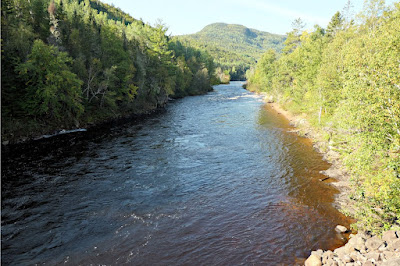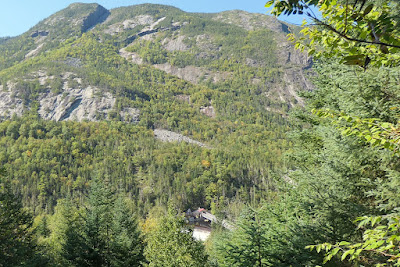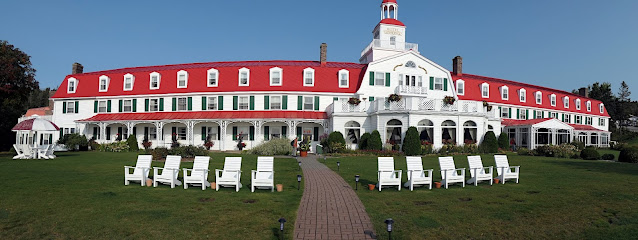On September 22, 2023, our NatHab group explored the Parc National des Hautes-Gorges-de-la-Rivière-Malbaie. The first stop, roughly an hour northwest from our hotel, was a hike to a viewpoint. We disembarked from our bus on the far side of the river Malbaie. (Click on any image to enlarge.)
The river appeared quite tannic at this time of year.We're taking the red dots for an out-and-back.The first section was a stroll along a gravel road.After a while, we reached a true trailhead.
We passed by some fascinating (reindeer) lichen, a token of clean air.In closeup.Pollution-sensitive bony-beard lichen dangled, flourishing, from some trees.It wasn't long before we arrived at the viewpoint.Our guides, Julia and Jackie encouraged us to spend a few minutes in quiet contemplation, with cliffs ahead and water below.
Then we retraced our steps and reunited with our bus and driver. It was only a short drive to the visitors center next to an old dam, originally built for logging, and picnic tables, canoe rentals, etc. Lunch was our first order of business!
The cliffs above the Malbaie are among the tallest rock faces east of the Rockies.
The river appeared quite tannic at this time of year.We're taking the red dots for an out-and-back.The first section was a stroll along a gravel road.After a while, we reached a true trailhead.
 |
| In English, "Maple Grove Trail" |
Then we retraced our steps and reunited with our bus and driver. It was only a short drive to the visitors center next to an old dam, originally built for logging, and picnic tables, canoe rentals, etc. Lunch was our first order of business!
 |
| An overview of the area. Click to enlarge. |
The watercraft zone is marked off above the dam.Here is a zoom-in map showing the shorter hikes and the watercraft area.Joan and I trod the shorter loops/climbs, which included an open-air viewing shelter (not much bird activity at this time of year) and some rough trail sections that we managed to navigate, but would have deterred casual walkers. In this photo, we're peering down towards the footbridge and dam.Then we decided to hike upstream alongside the
watercraft playground. After several bends in the river, we spotted the aquatic portion of our group, still happily paddling around, and decided to return to the visitor's center; we seemed to have enough time to explore the trail on the west bank below the dam. The dam itself hosted exhibits about the logging activity. The cut trees would be corralled (manhandled) into rafts that would float downstream to the mills. Today, those waters look like this.We explored the trail on the west bank. The Malbaie supports many critters, including owls, as evidenced by the rain-washed pellets we took to Julia and Jackie for examination.
The foam patterns on the dark river were intriguing.Joan and I then recrossed the bridge just in time to board the bus, and, well satisfied, our group returned to the Fairmont in La Malbaie.Tomorrow, we'll explore the Grands-Jardins National Park, a core element of the Charlevoix Biosphere Reserve, and move to a new hotel.
 |
| Photo of specimens in situ. |
















































